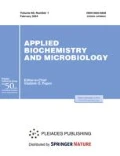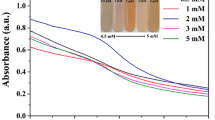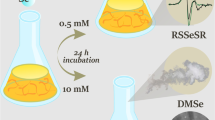Abstract
It was found that DAPS-25 in the presence of Saccharomyces cerevisiaе culture underwent a reduction, yielding acetophenone and elemental selenium. The latter appeared as selenium-containing spherical micro- and nanoparticles ranging from 50 to 400 nm in size. Under these conditions, sodium selenite was reduced with the formation of needle-shaped selenium particles up to 500 nm in length. The conversion speed of the formulation in contact with yeast culture fluid was independent of the nutrient medium content.
Similar content being viewed by others
Abbreviations
- HPLC:
-
high-performance liquid chromatography
- GC/MS:
-
gas chromatography/mass spectrometry
- DAPS-25:
-
diacetophenonyl selenide
- CF:
-
culture fluid
- EELS:
-
electron energy losses spectroscopy
References
Drevko, B.I., Antipov, V.A, Zhukov, O.I., Fomenko, L.A., Makarova, L.I., Drevko, R.I., Radionova, T.N., Efremov, V.I., and Kharchenko, V.G., The agent for the treatment and prevention of diseases caused by deficiency of selenium in farm animals and birds. RF Patent No. 2051681 A 61 K 33/04, 1996.
Drevko, B.I., Drevko, R.I., Antipov, V.A., Chernukha, B.A., and Yakovlev, A.N., An agent for the treatment and prevention of infectious diseases and poisoning of animals and birds boosting their productivity and preservation, RF Patent no. 2171110, A 61 K 33/04, 2001.
Boryaev, G.I., Blinokhvatov, A.A., and Vikhreva, V.A., A method for producing a biologically active compound, selenopyran, and products containing it, RF Patent no. 2281007, 2004.
Gigienicheskie kriterii sostoyaniya okruzhayushchei sredy. 58. Selen (Hygienic Criteria of the Environment State. 58. Selenium), Geneva: The World Health Organization, 1989.
Ermakov, V.V. and Koval’skii, V.V., Biologicheskoe znachenie selena (The Biological Significance of Selenium), Moscow: Nauka, 1974.
Chaudhary, S., Ahmad, U., and Mehta, S.K., Surface functionalized selenium nanoparticles for biomedical applications, J. Biomed. Nanotechnol., 2014, vol. 10, pp. 3004–3042.
Bangjun, Z. and Xiaoyu, L., Protective effects of selenium nanoparticles on oxidative stress and antioxidant enzymes activities induced by microcystins in the liver of mice, Shuisheng Shengwu Xuebao, 2010, vol. 34, no. 3, pp. 679–683.
Poluboyarinov, P.A., Vikhreva, V.A., Leshchenko, P.P., Aripovskii, A.V., and Likhachev, A.N., Elemental selenium formation upon destruction of the organoselenium compound DAFS-25 molecule by growing fungal mycelium, Moscow Univ. Biol. Sci. Bull., 2009, vol. 64, no. 4, pp. 164–169.
Tsivileva, O.M., Loshchinina, E.A., Pankratov, A.N., Burashnikova, M.M., Yurasov, N.A., Bylinkina, N.N., Kazarinov, I.A., and Nikitina, V.E., Biodegradation of an organoselenium compound to elemental selenium by Lentinulaedodes (shiitake) mushroom, Biol. Trace Element Res., 2012, vol. 149, no. 1, pp. 97–101.
Pankratov, A.N., Loshchinina, E.A., Tsivileva, O.M., Burashnikova, M.M., Kazarinov, I.A., Bylinkina, N.N., and Nikitina, V.E., Growth and metabolic effects of xenobiotic organic form of selenium in the Lentinulaedodes basidiomycete culture, Izv. Saratov. Univ., Nov. Ser., Khim. Biol. Ekol., 2012, vol. 12, no. 1, pp. 11–16.
Shebanova, A.S., Bogdanov, A.G., Ismagulova, T.T., Feofanov, A.V., Semenyuk, P.I., Muronets, V.I., Erokhina, M.V., Onishchenko, G.E., Kirpichnikov, M.P., and Shaitan, K.V., Application of the analytical transmission electron microscopy techniques for detection, identification, and visualization of localization of nanoparticles of titanium and cerium oxides in mammalian cells, Biophysics (Moscow), 2014, vol. 59, no. 2, pp. 284–292.
Drevko, B.I., Plotnikov, S.V., Mandych, V.G., and Nikurashina, M.L., Issledovanie reaktsii 1,5-difenil-3-selenapentandiona-1,5 v vodnykh rastvorakh galogenovodorodov: Karbonil’nye soedineniya v sinteze geterotsiklov (Study of Reactions of 1,5-Diphenyl-3-1,5-selenopentanedione in Aqueous Solutions of Hydrogen Halides: Carbonyl Compounds in the Synthesis of Heterocycles), Saratov: Nauchnaya kniga, 2008.
Author information
Authors and Affiliations
Corresponding author
Additional information
Original Russian Text © Ya.B. Drevko, T.S. Sitnikova, A.M. Burov, B.I. Drevko, S.Yu. Shchegolev, 2015, published in Biotekhnologiya, 2015, No. 6, pp. 65–71.
Rights and permissions
About this article
Cite this article
Drevko, Y.B., Sitnikova, T.S., Burov, A.M. et al. Reduction of diacetophenonyl selenide (DAPS-25 formulation) to acetophenone with the formation of selenium micro- and nanoparticles in the presence of Saccharomyces cerevisiaе culture. Appl Biochem Microbiol 52, 776–781 (2016). https://doi.org/10.1134/S0003683816080032
Received:
Published:
Issue Date:
DOI: https://doi.org/10.1134/S0003683816080032




